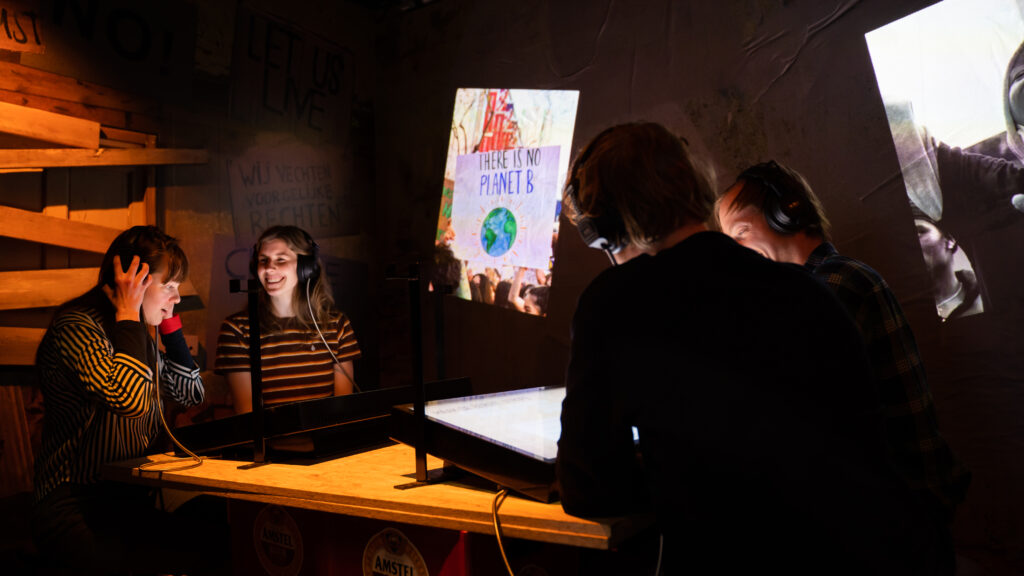26 October 2022
‘And, Lily, do you already know which book you are going to read for your fiction dossier?’
Lily supports her head with her hand and leans forward, bored. ‘I don’t like reading, ma’am. It’s so booooring.’ Her mouth lingers in the elongated oo of boring. I tell her that reading is good for her: ‘You know Lily, reading is actually a kind of work-out for your brain. Reading keeps your brain fit. ‘And,’ I say, ‘the more you read, the more fun it becomes.’
Lily’s head is now resting on the table. She acts as if she has almost died.
This scene played out in one of my first weeks as a Dutch teacher. My thought: as long as I tell my students why they should do something, they will naturally become motivated.
Little did I know.
Getting students to read is one of the biggest challenges of my profession. And that means I am always looking for new angles. I found these at my former employer IJsfontein. They developed the exhibition Back Street for the Literature Museum in The Hague. The aim of the exhibition: to get young people reading. Naturally, I was curious. Fortunately, so were my colleagues. We hired a bus and went on an excursion to The Hague with all 3rd and 4th vmbo and havo classes.
Voluntary engaging with literature
After a brief explanation on how to activate the games with our wristband, the doors opened to Back Street. A maze of small alleys from which you could reach 10 different rooms. A tattoo shop, a bunker, a converted limousine, an old arcade hall, a gym full of mirrors, a Mexican cantina and more. Students swarmed out and went to play, or take a selfie in one of the beautiful rooms full of books. Within no time, everyone was voluntary engaging with literature.
How could that be?
I called my former colleague and designer of this exhibition Raimond Reimers. What was his thinking? ‘The first thing I wanted to know was not: how do we get young people to read. I wanted to know why they don’t read,’ he says. He refers to research by special professor of reading behaviour Roel Steense. Steense describes 6 possible thresholds:
- Autonomy: can I choose what I read?
- Interests: can I read what I find interesting?
- Confidence: do I know I can do it?
- Connectedness: do I belong when I read?
- Value: do I think reading is important?
- Mastery goals: do I want to get better at it?
These barriers, or rather removing as many of them as possible, guided the design. The team started from 10 topics that show the breadth of literature. Think love, adventure, bullying and grief. ‘But,’ Raimond explains, ‘these are still very big topics, I really wanted it to match their interests.’ One example: for inspiration, the team dived into the most popular Young Adult books. Conclusion? It shouldn’t be about love, but about dating. That’s what interests them. This topic became the basis for a game where young people can experiment with dating in a converted limousine. In each game, different YA books recur in subtle ways. Characters from the books act as avatars in the game. In this way, young people do not have to expose themselves, but they can talk about difficult topics. Youngsters thus experience that in literature you can find recognition for your own problems and gain insight into the problems of friends around you.
Gateway book
The aim of the exhibition is to get young people to read. Every expert agrees that this can only succeed with the right book. Raimond explains that in the gaming world they talk about a gateway game. That is the game that makes you like playing games. You can also speak of a gateway book. That one book that suits you so well in terms of level and subject matter that you get that reading experience that everyone who loves reading talks about: that feeling that you don’t want to stop. After the visit, therefore, all students will receive an e-mail containing access to a search engine that lists books tailored to the choices they made in the Back Street games.
Show don’t tell
Back Street is a fantastic example of show don’t tell. A wisdom that is effective in almost any learning situation. And that is exactly what teachers can learn from this. Stop reading (and sharing) articles about how poor reading skills are. Stop reading articles explaining why reading is good for your brain. Stop. Go read books! A lot. Read and show that you read. For instance, the other day I was reading ‘the history of my sexuality’ by Tobi Lakmaker during a silent reading hour. I was chuckling out loud and saw Lily thinking. ‘Is she laughing at a book now? Is that possible?’
Definitely, Lily.
by Marieke Roël – Dutch teacher at X11 media and design

